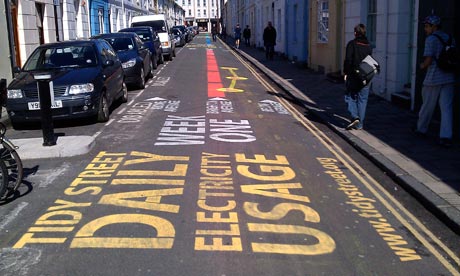The old adage that you can't manage what you don't measure is particularly pertinent when it comes to household energy use, which soared by 13.4% in 2010. Few people measure their weekly or even daily electricity consumption, which makes it hard for them to work out, where cuts might be possible – even if they wanted to.
Enter Tidy Street in Brighton. Residents who volunteered for a new energy-saving initiative have been given electricity meters so they can monitor their daily energy use, and identify which devices are using the most power, and when.
For the past three weeks, they have been entering daily meter readings on tidystreet.org, to build up a picture of each household's energy use.
Once people started measuring – 17 of the street's 52 households signed up straight away – local street artist Snub was commissioned to paint the street's average energy use against the Brighton average in a graph on the road outside their homes.
"It's a great way to do it," says Paul Clark, a software developer who has lived on Tidy Street for 10 years. "It engages people – passers-by often ask what it's all about – and for those of us that live here, it's something to be proud of."
Open-source software designed specially for the project allows each household to compare their energy use not only with the Brighton average, but also with the national average or even that of other countries.
Involving the community was key to getting the project off the ground, says Jon Bird, the project co-ordinator and designer of the software.
"I went along to the residents' annual street party last year, and explained what we were trying to do; that it was voluntary and that no one was trying to impose anything on anyone," he says.
"Then it was a case of identifying the 'champions' in the street – those who were going to tell their neighbours about the project; those who were going to be doing the measuring in the individual households."
Each household has chosen its own icon to mark the data points on the street and online graphs and residents' input helps foster the sense they own the project.
Ruth Goodall, 70, who has lived on Tidy Street for 30 years, says she wasn't interested in her electricity use before the initiative but measuring it every day has inspired her to change her behaviour. "I always used to fill up my kettle to the top but having seen how much extra power that uses I'm careful to just boil what I need," she says.
Strikingly, over the three weeks the project has been running, the street's average energy use has dropped by 15%, with some people cutting usage by as much as 30%. Much of this has been achieved by simple behavioural changes such as turning of lights and devices on standby.
"Now the challenge is to see if those reductions can be maintained," says Bird.
Phase two of the project is about to be launched, during which 10 households on Tidy Street will for the first time measure their gas usage over the next six months.
"We are also looking at working with community groups based in the city, such as Brighton and Hove 10:10, to encourage other streets and organisations in the city, to start measuring their energy use," says Bird, who has recently been approached by one school, keen to set up an electricity-use measuring project with its pupils.
Perhaps energy companies should take note. Next year sees the introduction of the "green deal", a scheme whereby people can invest in energy efficiency improvements to their homes, community spaces and businesses at no upfront cost, instead paying through installments on their energy bills. Community engagement will be key to their ability to deliver the programme.
• To find out more about the Tidy Street project and to
obtain the software, visit tidystreet.org or email Jon Bird

